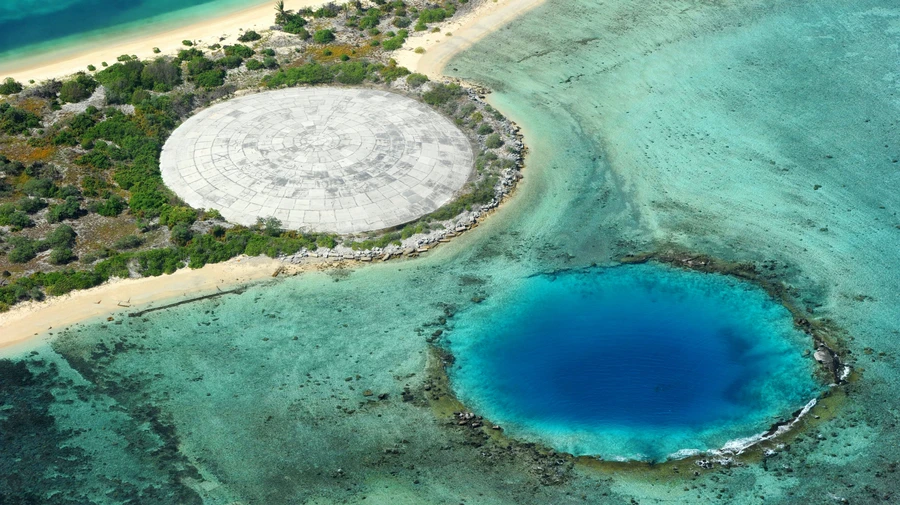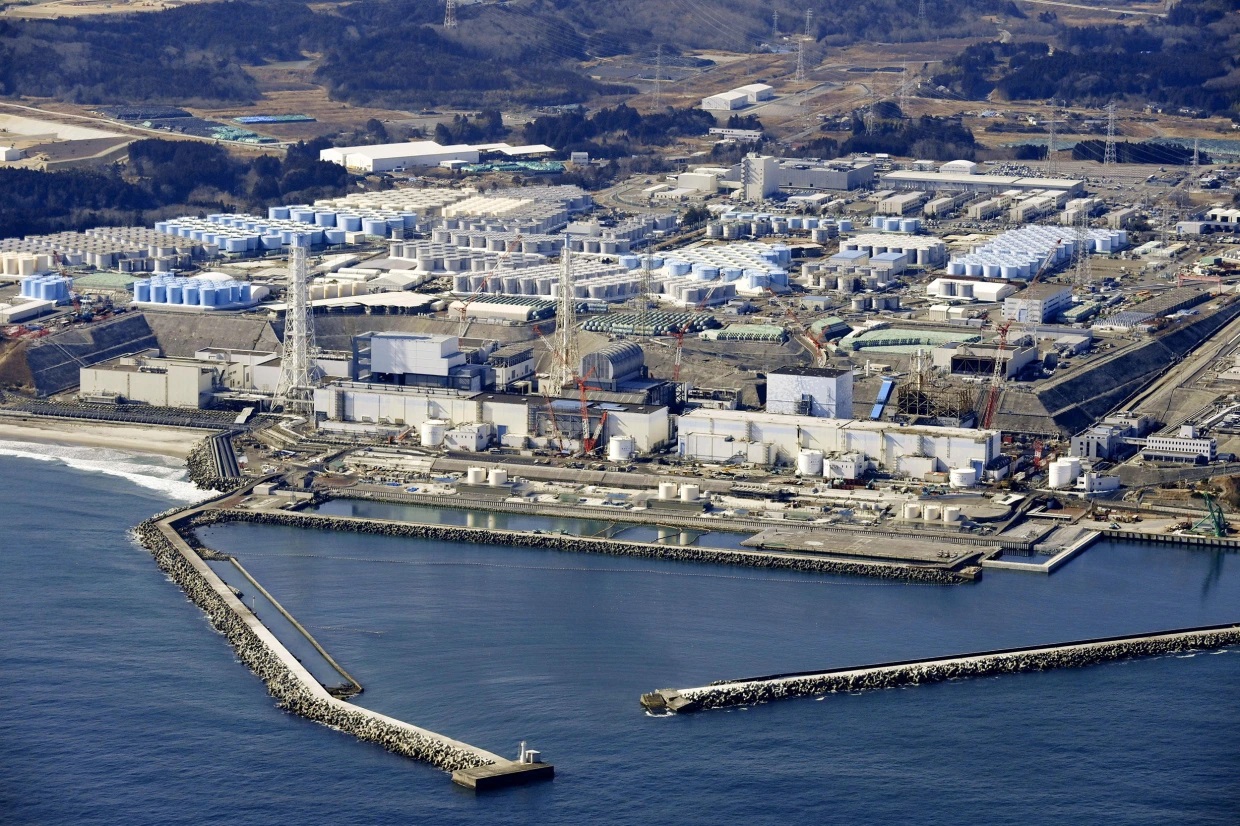Japan’s plan to discharge more than 1,000 tanks of nuclear wastewater into the Pacific has incensed island nations.
In the middle of the Pacific Ocean, a group of tropical islands has never seen winter. But one morning 70 years ago, a loud bang followed by a flash of light made it “snow” for the first time.
Fluttery and white, the powdery material sank into the Marshall Islands’ deep blue lagoons. It lightly covered the palm trees that lined Rongelap Atoll, astounding those who came out of their thatched homes to watch it settle on roofs. Children played with it, scooping the dust into their mouths.
But within hours, the atoll’s residents mysteriously began falling ill. Hair fell out in clumps. Skin burned. People vomited. They were evacuated two days later, but the damage was already done. Years later, the Rongelapese would suffer heightened cases of cancer, miscarriages, and birth deformities.
This was the fallout of Castle Bravo, the U.S.’ largest-ever thermonuclear bomb test that sprinkled radioactive debris on that warm March day. Now, residents of the island nations that include Fiji, the Marshall Islands, and French Polynesia invoke the nuclear accident and its subsequent contamination to oppose Japan’s plan to release its nuclear wastewater into the Pacific.
“We have a legacy of being the dumping ground when it comes to the issue of nuclear waste,” James Bhagwan, a Fijian anti-nuclear activist and secretary-general of the Pacific Conference of Churches, told VICE World News.
“Pacific Islanders have a spiritual bond with both land and ocean. So this again speaks to the issue of poisoning a part of us, our family,” he said.
The comparison Bhagwan drew between the controlled release of treated wastewater and an atmospheric nuclear test gone wrong may sound like a stretch. But it speaks to how much Pacific Island nations fear Japan’s planned discharge in the coming months of more than 1.3 million metric tons of contaminated water into the world’s largest ocean.
The nuclear waste sits in over 1,000 water tanks in Japan’s northeastern prefecture of Fukushima, the product of the meltdown of the Daiichi nuclear reactors there in 2011.
That year, a tsunami triggered by a 9.0-magnitude earthquake inundated the power plant and knocked out its cooling systems. Since then, officials have been trying to cool the destroyed reactors by pumping over a hundred tons of water through them every day.
But now Japan is running out of space to store this contaminated water, and is looking to release the treated liquid into the ocean this spring or summer.
Like Bhagwan, Pacific Island leaders have protested Japan’s plan.
“We must prevent actions that will lead or mislead us towards another major nuclear contamination disaster at the hands of others,” said Henry Puna at a public seminar last month. He’s the former prime minister of the Cook Islands and current secretary-general of the Pacific Islands Forum—a regional bloc of 17 island nations.
In objecting to the release, Motarilavoa Hilda Lini, a Vanuatu stateswoman, has cited the slogan of the Nuclear Free and Independent Pacific movement: “If it is safe, dump it in Tokyo, test it in Paris, and store it in Washington, but keep our Pacific nuclear-free.”
Scientists disagree over the extent to which the release of Fukushima’s treated wastewater could affect the Pacific Islands. Some claim that nuclear waste could enter human food chains and contaminate fish eaten by communities outside Japan. Other experts argue that the distance between Japan and the Pacific Islands, ocean current patterns, and marine behavior will make the risk of nuclear contamination for the Pacific Islands highly unlikely. The water will get released into the Pacific through an undersea tunnel, built one kilometer off the coast near the Daiichi plant.
Japan has insisted that the wastewater is safe to release following treatment by a system called ALPS, Advanced Liquid Processing System. The process is designed to remove all radioactive material found in the water with two exceptions: The radioactive isotopes of hydrogen and carbon, tritium and carbon-14, are almost impossible to filter out and will instead be released after the liquid is diluted to one-hundredth of its concentration with seawater.
Tokyo Electric Power (TEPCO)—which ran the collapsed Daiichi plant—said it would test the waste before, during, and after the wastewater’s release into the Pacific through an undersea tunnel over the span of 30 years.
While Japan maintains that the wastewater it will discharge will contain less tritium annually than a normal nuclear facility, the country’s own fishermen and neighboring South Korea and China have protested the decision. One Chinese official dared his Japanese counterparts to “take a sip” if the tritiated water was harmless.
Scientists who spoke with VICE World News and who are referenced in this article said that the amount of tritium Japan plans to release won’t be harmful to humans or the environment because of the small doses. And though ALPS can’t remove carbon-14, TEPCO told VICE World News that the radioactive isotope’s concentrations are well below the regulatory limit.
But despite the general consensus that low doses of tritium, which is found also in rain and seawater, have negligible effects on health, some scientists questioned whether the wastewater to be released truly meets the level of safety promised by Japan.
Ken Buesseler, a marine radiochemist and one of five experts on the Pacific Islands Forum’s panel of independent scientists, questioned TEPCO’s ability to sufficiently remove radioactive material from the liquid. He cited how, in 2020, the company had to retreat about 70 percent of the stored wastewater because it was found to contain amounts of radioactive substances exceeding standards.
“That doesn’t give me a lot of confidence,” he told VICE World News. Monitoring the wastewater after it was released into the ocean would be too late, Buesseler added, as once it’s in the ocean, TEPCO can’t get it back.
He also faulted the company for analyzing only about a quarter of the 1,061 tanks and providing testing results on just seven radioactive substances out of the dozens TEPCO said it would monitor. This, he said, ignored the possibility that there would be variation among the tanks, potentially overlooking harmful levels of more radioactive substances such as cesium-137 and strontium-90.
In a written statement to VICE World News, TEPCO said potential variations among the tanks have been accounted for and that each tank will eventually be tested before they’re discharged. Not all tanks have been tested yet because 70 percent of them currently do not meet TEPCO’s standard for discharge and will be retreated. TEPCO also said it would sample the water for 69 different radionuclides before it is released and that the test results would be audited by third-party agencies it appointed and Japan’s nuclear regulator.s.
Despite these measures, critics say that TEPCO has had a spotty record when it comes to communicating with the public. In 2018, Kyodo News reported that the treated water still contained radioactive substances above the legal limit after it had gone through ALPS. And it wasn’t until 2020 that the power company first acknowledged that the water contained carbon-14, which can’t be removed using ALPS.
“I saw this as an opportunity for Japan to build up trust, to take care of their waste, clean it up and demonstrate independently to the world that they’ve done that,” Buesseler said. “It’s a lot of trust, is what it really boils down to. And we’re saying, show us.”
Brent Heuser, a nuclear engineering professor at the University of Illinois in the U.S., told VICE World News he’s confident that, even if the tanks storing wastewater in Fukushima have higher levels of radioactive substances than is reported, dilution of the liquid is enough to ensure their safety. He noted that the company will discharge the water gradually over 30 years to sufficiently thin out the wastewater.
Paul Dickman, a radiochemist who has visited Fukushima multiple times over the past decade to advise Japanese regulators on nuclear waste cleanup, supports the safe release of the treated water, although he acknowledged that the debate also hinges on trust.
“Let’s face it. I think the central government lost trust and trust is very hard to rebuild,” Dickman, a former senior official of the U.S. Nuclear Regulatory Commission and current chairman of the American Nuclear Society’s external affairs committee, told VICE World News.
The International Atomic Energy Agency, an intergovernmental organization within the UN system that advocates for the peaceful use of nuclear energy, has tested the wastewater and found the plan to release it in line with global practices.
But scientists who support the discharge say worrying about the treated wastewater was ignoring the more pressing concern: what TEPCO will do with the fuel debris in the reactor vessels.
When the 2011 tsunami hit Fukushima’s three reactors, power sources and equipment used to cool the fuel inside shut down. This allowed the fuel to overheat, melting the core and other parts of the reactor. Once it cooled and solidified, it became highly radioactive material known as “fuel debris.” At the moment, it sits at the bottom of the three reactor vessels and needs to be cleaned out before the plant can be decommissioned—making it a far greater issue than what’s in the tanks, Dickman said.
“It’s like, if you’re worrying about the air freshener in your car and you’re not worrying about the tires, then you’re not paying attention,” Dickman said.
Though the deadline for Japan’s release of the treated wastewater is fast approaching, the country is yet to fully convince Pacific Island nations that its plan won’t be harmful. The tanks fill up day by day, swelling to their 1.3 million ton limit.
Now, the Pacific Islands are running out of time to defend their oceans, the environmentalist Bhagwan said, warning Japan of the consequences that could lay ahead.
“The culture of shame will be laid upon the Japanese government and the people of Japan in years to come. Do they want that to be part of their legacy?” he said.
This story was written by Hanako Montgomery, originally published at Vice on 18 February 2023, reposted via PACNEWS.




